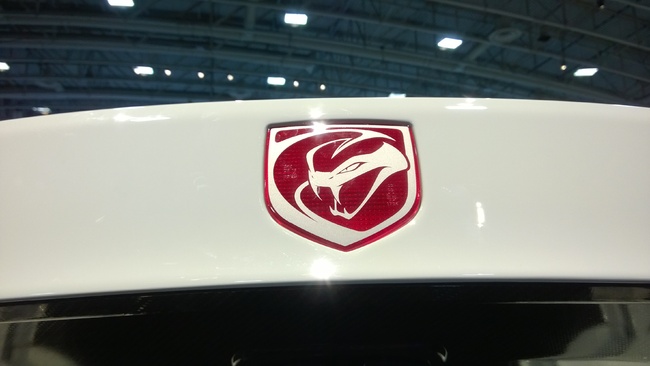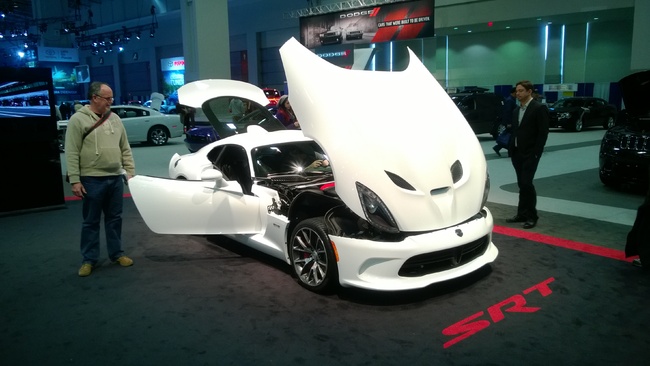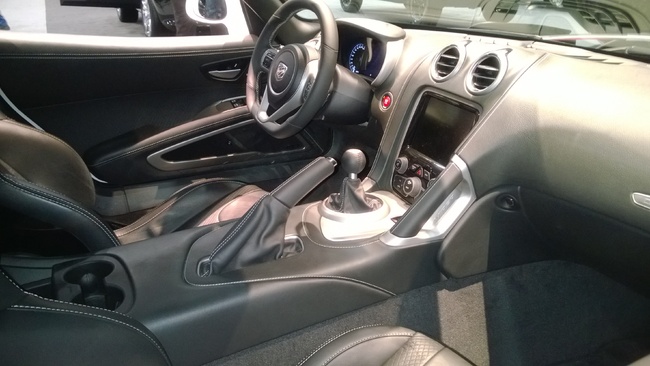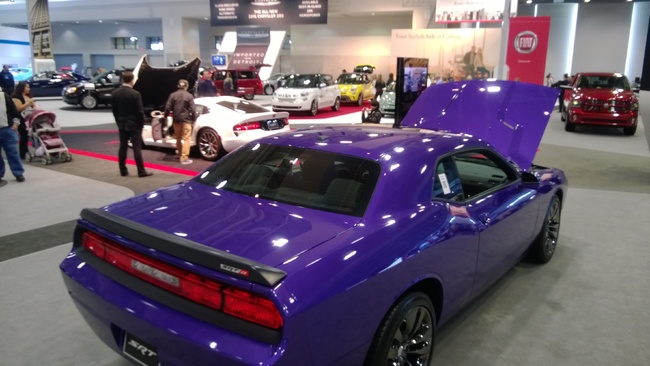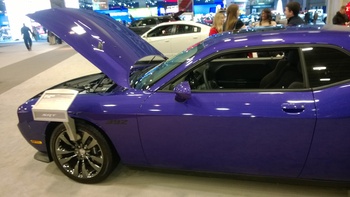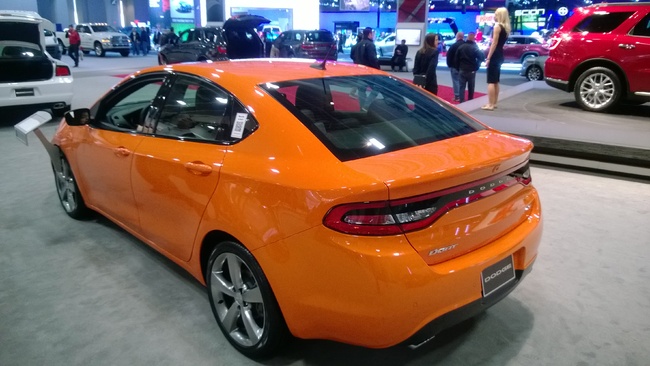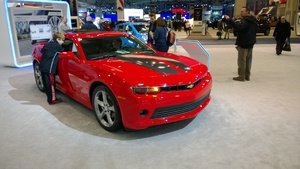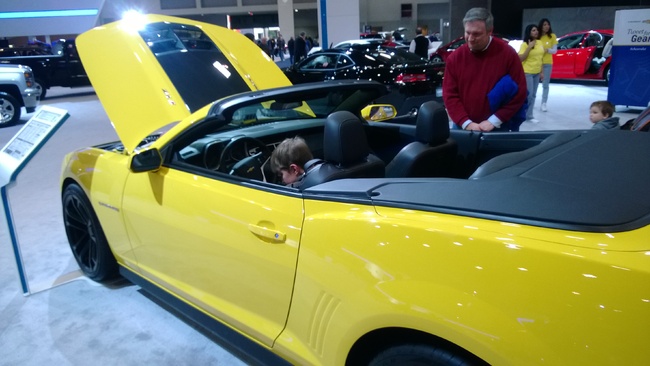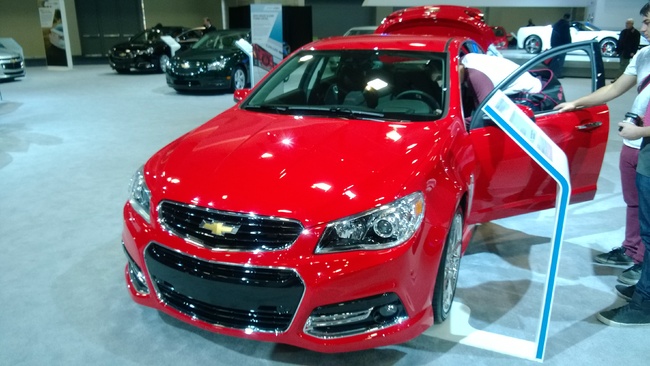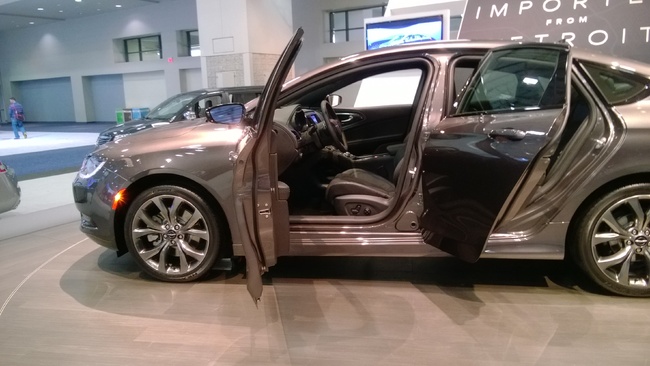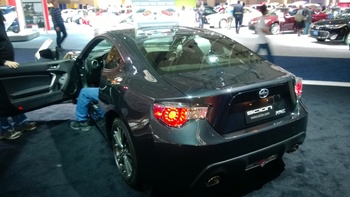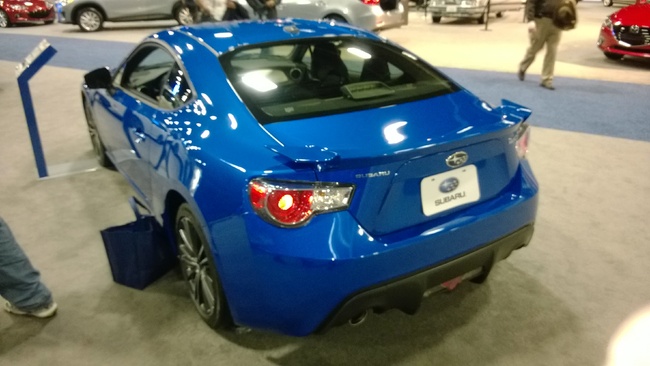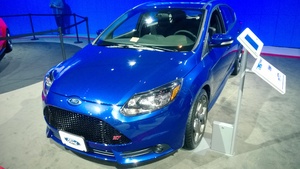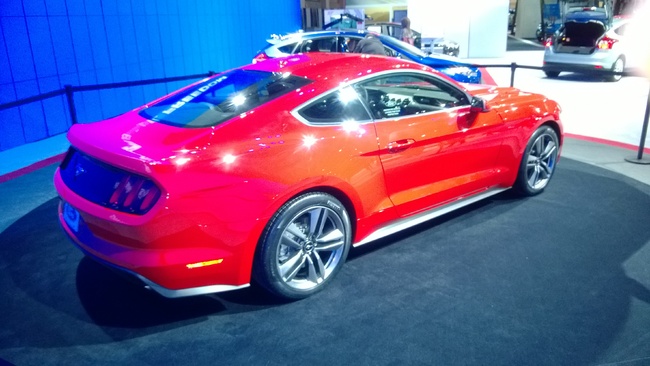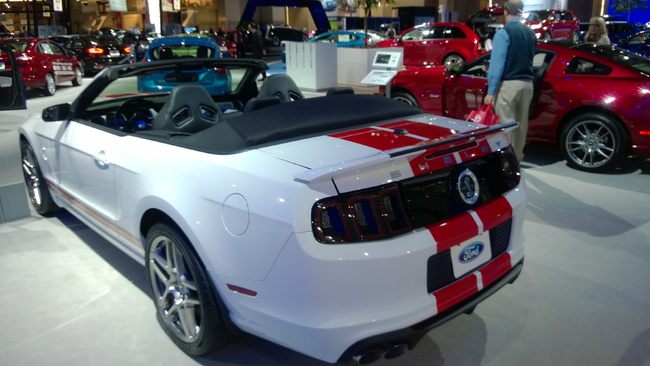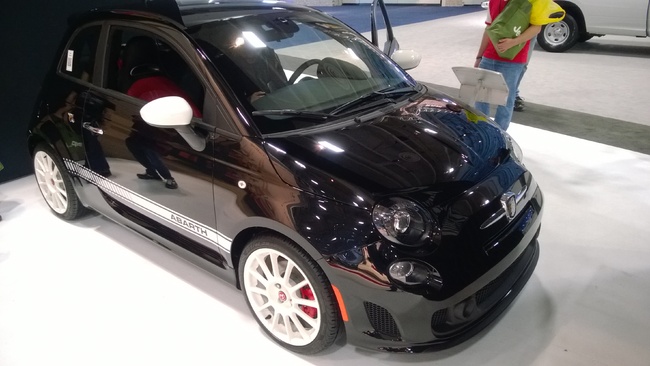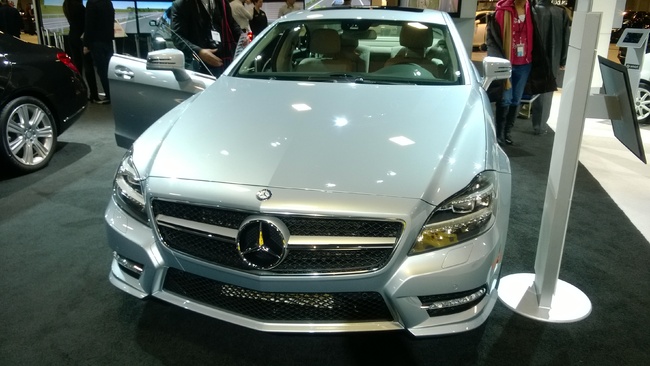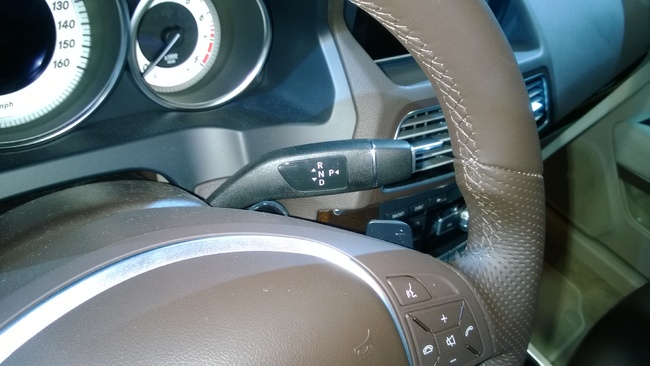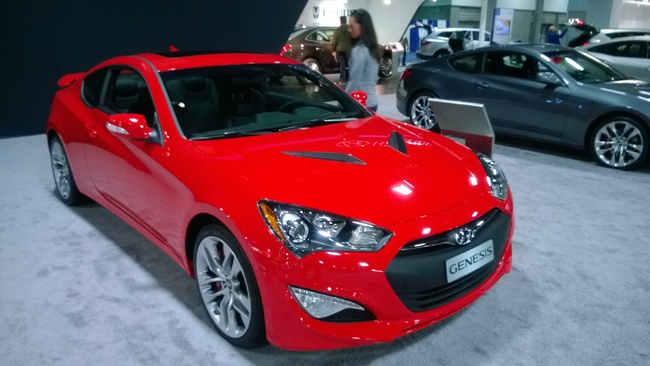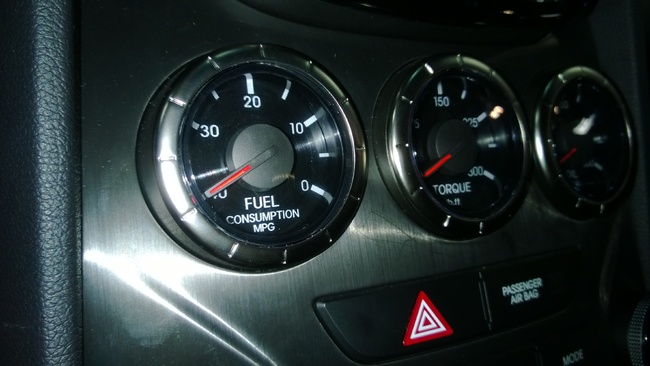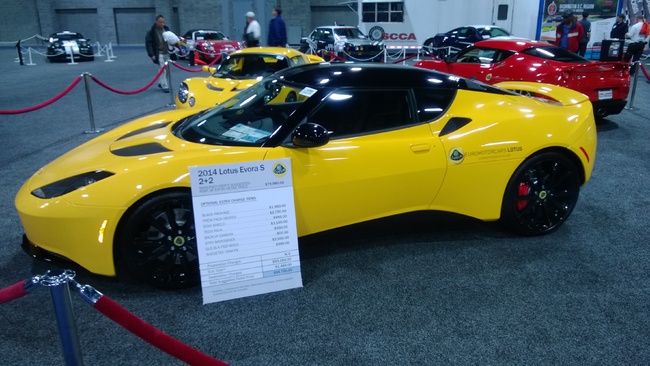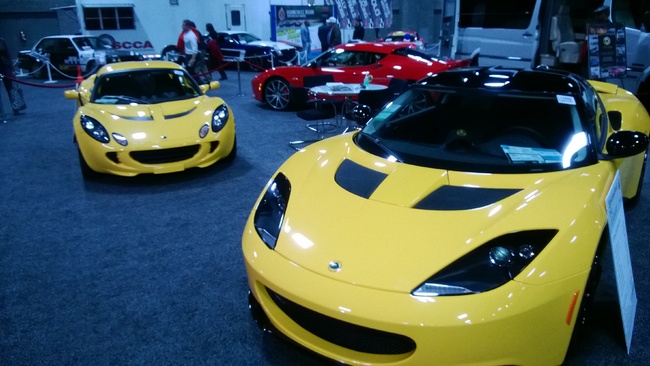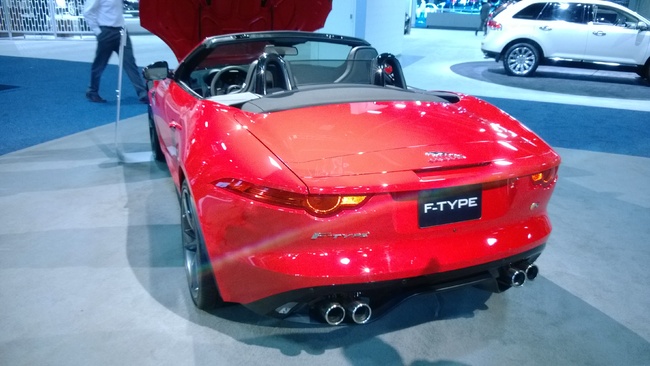LeadFoot: The Washington Auto Show
 Monday, February 3, 2014 at 5:01PM
Monday, February 3, 2014 at 5:01PM  Auto shows are, at their heart, trade shows. I've been to some in my day, mostly in the entourage of an exhibitor. It's not as glamorous as all that, since it really means it was my uncle's company exhibiting and it meant a company-paid trip to Chicago or Hawaii.
Auto shows are, at their heart, trade shows. I've been to some in my day, mostly in the entourage of an exhibitor. It's not as glamorous as all that, since it really means it was my uncle's company exhibiting and it meant a company-paid trip to Chicago or Hawaii.
But for the first time, I decided to just attend one. No ties to any company, just my brand loyalty. And since I'm within a well-executed stone's throw of DC, I figured "Why not?" as I looked at the show's logo, trying to decipher what car exactly they used in their logo. I'll tell you one thing: those headlights look impossible. Surely there wouldn't be any space at all between the back of the headlights and the front wheel well.
But to be fair, a bit of creative license is to be expected from the general automotive public. After all, there are throngs of people who think a Prius uses no gasoline, that all electricity is free, switching the infratstructure to ethanol fuel won't affect food prices, the BMW 1-Series is front-wheel drive, and four-wheel drive is essential when the driveway gets a few leaves on it. There's just no educating some people.
Arrival
What else was I going to do but drive there? Sure, there's public transit access in DC and the city is notorious in my mind for hating the automobile, but this is an auto show!! To arrive any other way would be blasphemous.
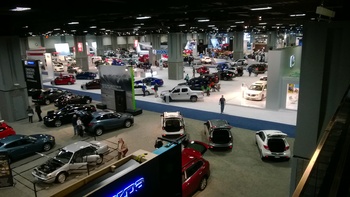 The show is held on two floors in the Walter E. Washington Convention Center. As I wondered whether the guy's name was "Walter E. Washington," or just "Walter E." and this was the "Washington Convention Center," I chanced upon some valet parking within a block of the center. An especially good omen in the District.
The show is held on two floors in the Walter E. Washington Convention Center. As I wondered whether the guy's name was "Walter E. Washington," or just "Walter E." and this was the "Washington Convention Center," I chanced upon some valet parking within a block of the center. An especially good omen in the District.
$12 gets you a regular ticket on general public days, which means full access to the show floor. Sure, you don't get to see the big press conferences, but it's no big loss since those really all happened in Detroit last week.
And while I'm on the subject of that particular Elephant in the room, let's be honest a moment. The North American International Auto Show in Detroit is the one everyone really wants to see. Detroit, Geneva, Tokyo, New York (to a degree), SEMA (to a lesser degree); these are the big ones where everything gets revealed. But to be clear, that happens on press days. Then the shows are open to the public, but all the cool stuff is still roped off on rotating plinths. Such was the case here, only there are fewer automakers, they have smaller exhibits, and the cool stuff is still roped off.
Because of how the convention center is designed, attendees are drawn more easily to the upper floor, where the domestic automakers set up shop. But by my count, "Domestic" is a bit of a misnomer. Upstairs, I counted GMC, Chevy, Buick, Chrysler, Dodge, Jeep, Ram and Ford, but in addition Toyota, Scion, and Fiat. Interestingly absent were Lincoln and Cadillac. Now, I know the definition of a "Domestic Automaker" is up for debate, but I seriously wanted to ask "Who told you what a domestic automaker was?"
But I'm not in charge of booth assignment. So while I was there, I made a bee-line for the one I really came here for.
SRT Viper GTS
Giddy with joy, I approached the gloss-white snake. I've been hounding the Internet for information on this ever since the first rumors popped up. I remember the silhouette teaser before the grand reveal and how well they kept the lid on the car's actual looks, despite having revealed it to key dealers almost a year before. The 2005 Viper was the first car to get me interested in cars. It was unruly, powerful, and unlike anything else on the road. I was driving an old Dodge Caravan at the time, and I heard about this and said, "Wait, the people who made my car also made this?" Until then, cars were just a way of going from A to B. Didn't occur to me that these marvels of engineering could be fun.
The Chrysler group built this as their halo car. When it was branded as a Dodge, it served as a rolling advertisement, selling Rams and Chargers because they were made by the same people. Granted, the Viper, Ram and Charger are made in completely different factories and had different designers, but to the common man all Dodge vehicles come from the same place. The same is true now, clearly, as they placed the Viper directly in the center of their exhibit, surrounded on all sides by Ram, Dodge, Chrysler, Fiat and Jeep. And this was the first time I'd seen the sixth generation of the beast in person.
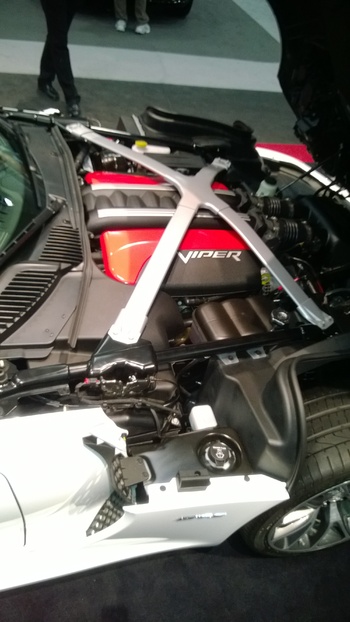 A booth attendant had wisely left the hood up, leaving the monstrous 8.4 liter V10 exposed beneath the cross brace. The first thing you notice (apart from the massive intake manifold), is that this was built solely to fit that engine into the body. Every component not attached directly to the engine is stuffed in the fender wells. The washer fluid reservoir, for instance, hides behind the right-front wheel because there's nowhere else for it to go. SRT will tell us that the battery is installed in the trunk for better weight distribution, but I think they just couldn't find room for it up front.
A booth attendant had wisely left the hood up, leaving the monstrous 8.4 liter V10 exposed beneath the cross brace. The first thing you notice (apart from the massive intake manifold), is that this was built solely to fit that engine into the body. Every component not attached directly to the engine is stuffed in the fender wells. The washer fluid reservoir, for instance, hides behind the right-front wheel because there's nowhere else for it to go. SRT will tell us that the battery is installed in the trunk for better weight distribution, but I think they just couldn't find room for it up front.
Less cramped was the trunkspace. While you won't be moving any apartments, there's still a fair bit of space for things. A pair of people could pack a bit of luggage in there and head on a few-day long road trip.
Then came the time to climb in the driver's seat. There wasn't a defined line, but sometimes you stand waiting, then you don't want to look impatient, so you look around front at how the brake ducts are integrated into the front grill, then by the time you come back someone who wasn't there before had jumped in. I don't want to say it was frustrating, but... well, yeah, it was frustrating.
But, when I finally did get some seat time, I was in for an education. Everything flows around the driver, who sits not so much in a driver's seat, but in a cockpit. Sure, the passenger could access the center console if they desired, but the idea is that they be do concerned with hanging on for dear life that switching on the radio should be the least of their concern. Everything is well within reach.
But looking down at your feet, you get reminded that this car is all about the engine. Such a big engine does take a big transmission, so to make room for it all the pedals were shifted to the left, so you end up sitting in with your feet just as shifted. It's not as if they made extra room to the left of the pedals, either (not that they could, having stuffed everything into the fenders), so my size twelve clodhopper steel-toe boots couldn't press down the clutch without also pressing the brake, so it was unwise to test shifter action.
Eventually, you have to get out of the nice car that's sitting on the expo floor. Especially if it is a nice car, because other people want to get in it. I was indeed sad to turn my back on the Viper, but of course I returned to it a few times to admire again.
Dodge Challenger SRT8
In case you couldn't tell, I really only came to the show to see the Viper. That was totally worth twelve bucks. But looking around, I saw how totally acceptable it was to hop into the front seat of a six hundred horsepower, $120k car, even if you're six years old, so I asked myself, "Why not test out a bunch of cars? Particularly the interesting ones?"
Which brought me to the Challenger, parked a hop and a skip (but just shy of a jump) away from White Snake.
The Challenger is a victim of its own success, in my book. Coming out in 2008, the retro looks were lauded by public and press alike, but they found the right proportions too soon, and haven't been able to depart from it. As such, the 2014 Challenger looks an awful lot like the 2008 Challenger. There's nothing wrong with looking good, but it is essential to keep the car-buying public excited. Think of it this way: the Mustang is about to go through it's second styling refresh since the Challenger arrived. Personally, I think the rumored Barracuda is due.
I once had the chance to sit at the helm of a 2012 Dodge Charger. The Challenger's interior draws strongly from the big sibling. It makes sense, given they're on the same platform. And since the Charger is a hefty girl, so is the Challenger. And sitting in there, you get the real sense that it is massive, even without throwing it around a corner.
The SRT8 in question was indeed a stick-shift, as it should be. But looking around the center console, I started wondering, "Where's the handbrake? How do you park it?" Indeed, the parking brake is a foot pedal. I've seen images of past Challengers with a row-your-own gearbox, and those had handbrakes. So why the change?
Bewilderment aside, the Challenger is pleasantly spacious, which is important for someone of my height. While I haven't experimented completely, I feel confident that the Challenger's interior would be sombrero-friendly.
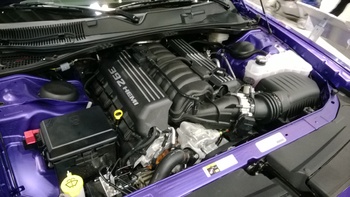 This being a muscle car, the main focus for enthusiasts would be the engine. Even though the Challenger is massive, the 392 cubic inch block sits snug in the nose of the barge. This has been a trend for cars the past 30 years. More and more, automakers try to make it difficult for the consumer to perform at-home maintenance. This is because they make money not only on selling you the car, but on parts and labor when you bring it into the dealer for maintenance. It's annoying for us do-it-yourselfers, but the tradeoff is cars have become lighter, more aerodynamic and fuel efficient as a result of the tight packaging. We'll gloss over the fact that mandatory safety regulations have undone all the weight saving for now.
This being a muscle car, the main focus for enthusiasts would be the engine. Even though the Challenger is massive, the 392 cubic inch block sits snug in the nose of the barge. This has been a trend for cars the past 30 years. More and more, automakers try to make it difficult for the consumer to perform at-home maintenance. This is because they make money not only on selling you the car, but on parts and labor when you bring it into the dealer for maintenance. It's annoying for us do-it-yourselfers, but the tradeoff is cars have become lighter, more aerodynamic and fuel efficient as a result of the tight packaging. We'll gloss over the fact that mandatory safety regulations have undone all the weight saving for now.
As a final note on the Challenger, I'm not crazy about the color purple on a car. I guess I could see it with white stripes along the belt line, as you could get on the R/T Classic trim of this car, but you sacrifice the big Hemi, having to make do with the slightly smaller one. Seems a high price for stripes when you could just get the car in orange paint.
Dodge Dart
Wrapping up my visit to the house of the crosshair grille is the Dodge Dart. I really liked the idea of the Dart when it came out. Not since the Neon has the Chrysler group had a small car that didn't bring shame upon the company. A lot of people missed the Neon dearly when it was usurped by the Caliber in 2006. The Neon was just simply a small, affordable, not terrible car. Plus, it came in the hilarious SRT4 trim, which mounted a great big turbocharger to the 2.4 liter double overhead camshaft engine. This gave the little tuner car an insane (for the time and size of the car) 215 horses, but the lack of any form of traction control meant one thing: when stomping on the gas pedal, the car would find the front wheel with the most traction and then send all the power to the other one.
We have yet to see the Dart in any SRT trim yet (fingers crossed), but the results of the Chrysler-Fiat partnership look good--on paper.
Reviews have found the engine choices to be on the underpowered-side. Until an SRT trim arrives to remedy that, this will be due to the Dart's size. Dodge did say when this was announced that it was "the largest in its class." So, how much bigger would it have to be to become the smallest in its class?
But inside, the size makes sense. It is spacious, even for me, and that doesn't happen often in this class. The seating makes it feel bigger than it is. The console is fairly low, leaving capacious elbow room. The Dart I sat in was wired up to the mains, so the battery wouldn't drain while Dodge showed off the UConnect system in the dash. I played with the system in the rented Charger back when, and this was delightfully similar. Everything on the touchscreen is straightforward and the response is snappy. And everything important (media, ventilation, etc.) has redundant physical controls on the console or steering wheel.
Overall, I could see myself driving one. But talk of low power/weight ratio worries me. I'd much rather wait for an SRT trim. With any luck, they'll give the trim all-wheel drive to help with the power boost.
Chevrolet Camaro
I've never been a fan of the Camaro's look. I can see shades of the iconic Camaro that everyone adores and pays hundreds of thousands of dollars for restored ones at big name auctions, but I don't see the appeal. Yes, it handles well because it comes from an Australian chassis related to the excellent Pontiac G8. And plenty of power available should tick all the boxes on the gearhead's checklist. But I'm afraid the car's eternal connection to Michael Bay's Transformers franchise, a series of Michael Bay films directed by Michael Bay, works against the Camaro in my book. Is it logical? No. Is it fair? Probably not. But I just can't get past how terrible I find those films. And the franchise didn't even play a big role in my childhood, like it did for so many of my demographic.
As I should have expected, the Camaros were swarming with kids. One of them was even yellow, furthering my eye rolling, so every third child would say "Look! It's Bumblebee!"
Eye rolling over with, I timed my approach with the scattering of children by their parents and got some seat time in the red coupe. My first thought was "Where's the seat adjustment? I don't have anywhere to put my head." I was dismayed to find that lowering the seat only gave me another half inch. I could see maybe pulling the stock seats for some Recaros and taking it racing, because the car does have performance chops. But for every day, I'd have to take a pass. And while the view forward down that long striped hood is impressive, that's about all you're going to see. Practically no visibility out the other windows.
But inside is fairly well-laid out with one exception. I do like the four-guage cluster at the bottom of the console in front of the shifter, but the view is blocked partially by the HVAC knobs. Amazingly, even the view of the interior is compromised. I'm not sure if I'm impressed or dismayed.
But there is one way to solve the view problem, and that's hop into the convertible ZL1 Camaro. First, you drive with the top down everywhere you go. Second, that supercharged V8 will make sure you're only looking straight ahead anyway.
Chevrolet Corvette Stingray
I have a lot of respect for the Vette. I am still a Mopar guy, and I credit the Viper with making the Vette as good as it is, but I do respect the Corvette's performance credentials and history.
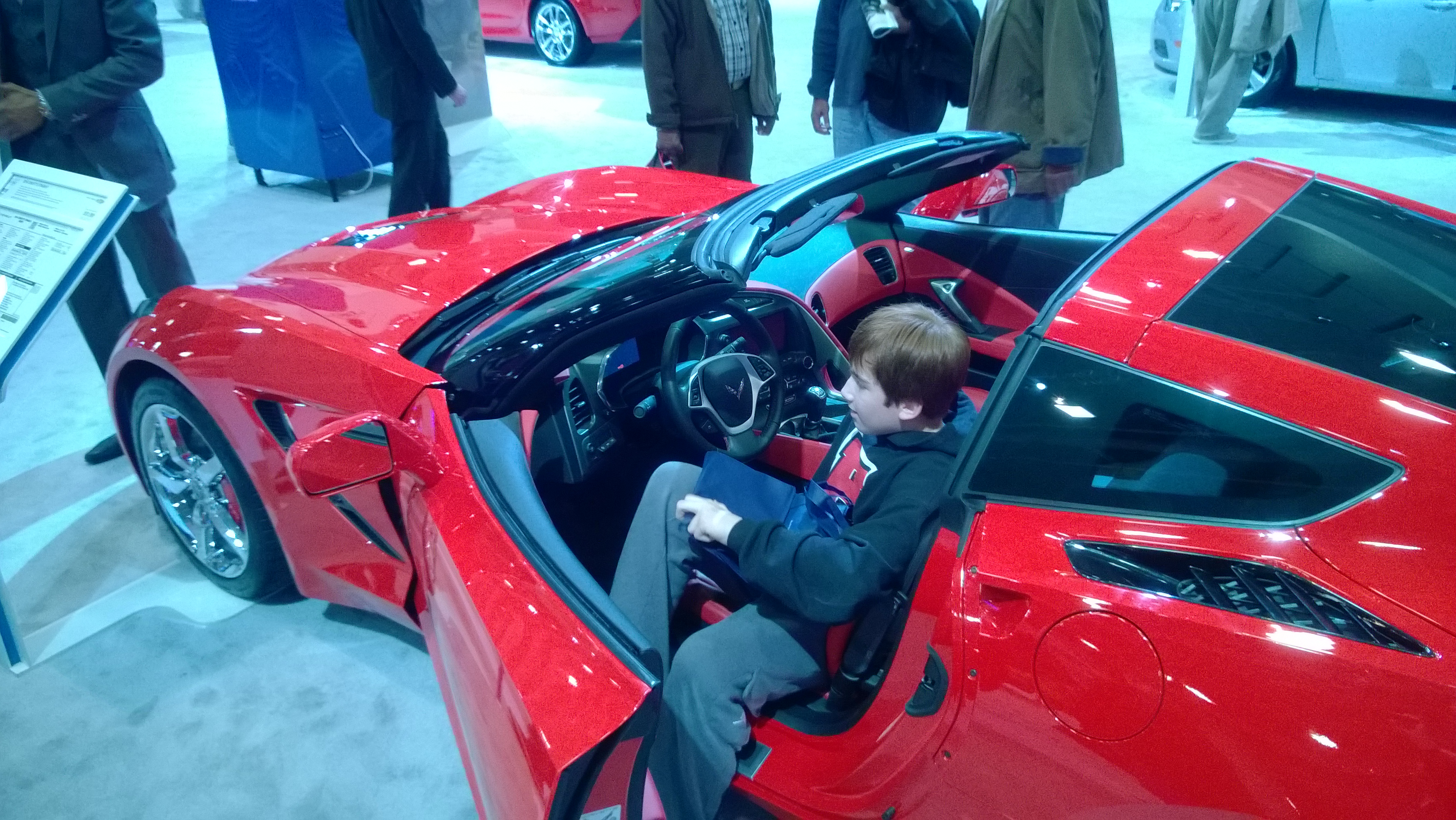
In my opinion, this is the first properly good-looking Corvette since the seventies. The C4 and C5 were a time of woeful styling, to be honest. Sure, the whole industry took a page out of the bland book, but we're talking about America's sports car. There needed to be excitement there. The C6 did have some spark, given it's classic sports-car proportion, but it was hard for me to get excited when it looked no more exiting than a Chevy Malibu. Part of that, I'm sure, is the Corvette's popularity. GM does sell this thing in droves, and they do have a passionate owner base. Corvette guys will not hesitate from using it as their daily driver (wouldn't you?). As such, you see Corvettes everywhere you go, and it's like too much of a good thing, extinguishing the spark.
But I think we have it back with the C7. I see a bit of Viper influence in the lines, and that's good. The Corvette needs to look like nothing else on the road, and few do that better than the Viper. The striking design clearly conveys that this is a car for excitement. I'm just looking forward to what they'll do to the looks of the ZR-1 edition of the C7 when it finally comes out.
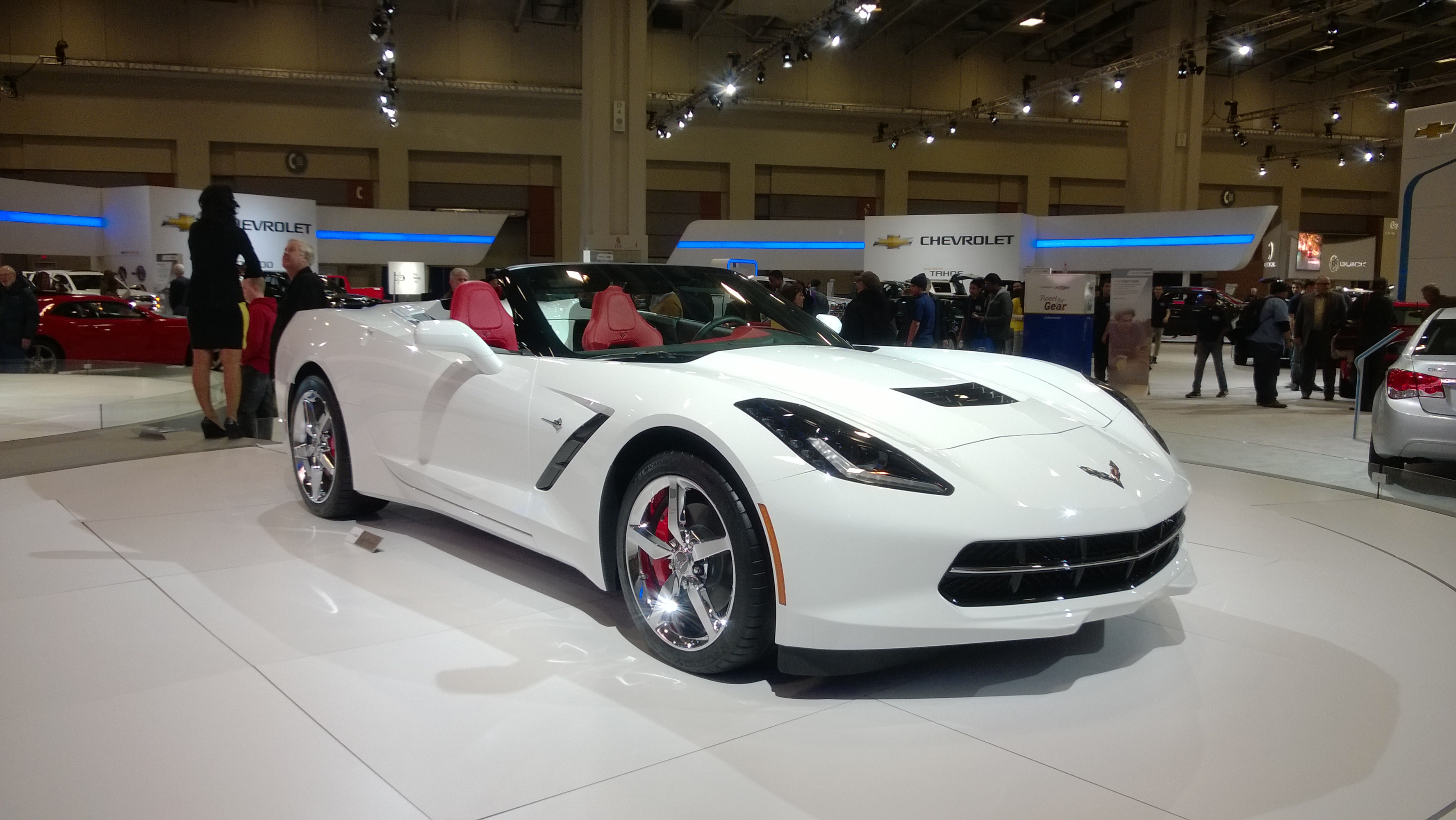
Because the Vettes and Camaros were in such close proximity, these, too, were swarming with children. But having practiced my timing with the Camaro, I got in and immediately felt comfortable. My feet weren't shunted over to the left, like in the Viper. A deep-blooded Mopar guy like me would say that's because the Vette's engine is too far forward, killing the weight distribution, but the level-headed car guy in me remembers this is a 6.2 liter V8, not an 8.4 liter V10. The transmission needn't be so far back in this.
The red Vette that I was in had the roof removed and stored in the trunk, leaving open air above me. But I was still acutely aware that the top of the windshield was awfully close to my eye level. And the Vette doesn't have a bubble roof, like the Viper, which did have room for my head. So GM seems to be prejudiced against tall people with their sports cars.
But other than vertical room, the Corvette is not an unpleasant place to be. Fit and finish in the cockpit is on par with what would have cost four times as much three years ago. I can definitely see why Corvette guys drive them every day. Although maybe not the tall ones.
Chevrolet SS
Not much to say about the SS. GM is taking the fight to Dodge's Hemi Charger by combining the engine of a Camaro with the styling of an Impala. Don't get me wrong, I think it's a handsome vehicle. But it isn't exciting. Where the Charger is distinctive and aggressive, the SS isn't. This is, by and large, the direct successor to the fantastic, though short-lived, Pontiac G8. Australian handling and American power will make it a fun drive. But with those conservative looks, it might as well have been a Buick. I'd either search for a lightly-used G8 or wait for an aftermaket outlet to create an appearance conversion kit, because the Pontiac looked so much better. Damned bankruptcy.
Chrysler 200 S
The 200 was the disappointment of the show. Before you car guys get up in arms, let me clarify: I really wanted to look closer at it. But, of course it was only unveiled a week ago at Detroit, so it was showcased on a rotating platform at the head of Chrysler's display. They even posted a skinny girl in a dress to keep people from touching it. I wasn't about to argue with her.
Chrysler has needed a decent competitor in the mid-sized sedan market since, well, before there wasa mid-sized sedan market. The pains of the Sebring are still with a lot of us, even though it was restyled and rebranded as the 200 in 2011, introduced by Eminem in a Super Bowl commercial. I really want this to be a success, because it's the Average Joe cars that make an automaker money so they can continue projects like the Corvette and Viper, which in turn act as marketing tools to sell more Average Joe cars.
I'm most excited about the announcement that this will be available with all-wheel drive. This harkens back to the 200C concept from 2009, which was a highly modular platform friendly to hybrid or electric drivetrains, as well as front-, rear- or all-wheel drive. All-wheel drive will, in my opinion, finally put Chrysler in league with the German luxury sedan names. Sure, Mercedes just launched the CLA, their budget-minded front-wheel drive car, but the cars they make that you really want are going to be rear- or all-wheel drive. Chrysler can't very well think they can compare themselves with the big German marques with a front-wheel drive only car.
Now, if they could just put forced induction on the engine and some big brakes, Chrysler could have an M3 fighter on their hands.
Toyota
The house that Kiichiro built is so off my radar that the only reason I was in the booth was because it was on the way to the Ford area. What I found was a sea of mediocrity. Five (supposedly) different Prius models in a row. Gripping stuff.
There was even this wall display:
Exactly like the old one. Harsh words, I'm sure, but their cars don't give me a lot to go on.
Scion FR-S
Toyota has basically shifted all the cool cars to Scion. That said, Scion has, in my opinion, two cool cars: the tC and the FR-S. The tC got coolness creds the past few years when it got a facelift and looked less like a Toyota, but as much as it tried to appeal to the tuner and enthusiast crowd, the tC remains, critically, front-wheel drive.
That's where the FR-S comes in. Developed jointly by Toyota and Subaru as the FT-86 project, the FR-S and the sister Subaru BRZ promised to be an answer to the question, "Where's the affordable driver's car?" With a naturally-aspirated boxer engine, rear-wheel drive, and starting at $25k, that's quite an answer.
I've always liked the idea of the FT-86. A small, sporty, oversteer-friendly coupe? Sure. But I could never get into it. I guess I'm just mad that an American marque didn't do it first.
But it's hard to argue with the results. Certainly is the darling of the automotive press. But for whatever reason, when I sat in it, I forgot that it was only $25k. Sure, that's a lot of money for most people, but as far as new cars are concerned (let alone sports cars), that's downright cheap. I hear the praise for this car time and time again, so I expect so much more than I see.
The car is small. There's no excuse for thinking otherwise. But it's also cheap. The cost of development and manufacturing has to come from somewhere, and in the FR-S it came from the interior materials. It just feels... cheap, for lack of a better word. Sure, it's got Toyota's signature fit and finish, but materials were definitely not taken from the Lexus parts bin.
The funny thing I noticed was the gear shift knob had been removed. This seemed like a funny thing to me. Scion had a second FR-S on display, and that was missing the same interior component. I find it funny that in all the decades of the automobile, the go-to method for installing a gear-select knob is still to screw it down on a bolt. There's no clip or snap or rivet or proprietary latch of any kind. Guess it keeps the aftermarket alive.
Perhaps my soured attitude toward the FR-S would be turned around if I were to drive it, but this is an auto show; not an infinite lineup of test drives on an autocourse. Until such time as that is my job, my opinion stands. The FR-S feels cheap.
Subaru BRZ
I'm skippin ahead in my tour of the auto show for a moment simply because the FR-S and the BRZ are the same car. Or are they?
I've only spent a few minutes in the Scion, and I had my feelings about it. But one look at the BRZ's interior told me "Yeah, this feels cheaper."
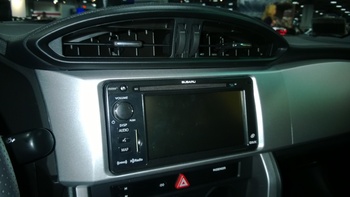 By and large, it felt the same. What is probably an excellent car to drive is let down by a feeling of cheapness inside. Again, the gearshift knob was missing. Maybe a Toyota/Subaru thing? Are they that cheap they couldn't put a knob on the selector for their show car?
By and large, it felt the same. What is probably an excellent car to drive is let down by a feeling of cheapness inside. Again, the gearshift knob was missing. Maybe a Toyota/Subaru thing? Are they that cheap they couldn't put a knob on the selector for their show car?
What made me shake my head, though, was the media unit in the center of the dash. Seriously looks like something bought from Crutchfield Clearance, if Crutchfield Clearance had a "This crap really has to go" section in its site. I understand that most components are probably going to be replaced in these cars, but shouldn't stock parts at least look like stock parts?
Ford Focus ST
Hot hatchbacks never really went out of style sine they first came on the scene around the time of the Shelby-tuned L-Body Charger in the 80s. The Focus ST is the spiritual successor to the Escort Cosworth, and it show in many of the stuling cues. As someone not normally a fan of hatchbacks, I can say they strike a chord with me. I'll always prefer the long low hood of a traditional sports car, but I understand the appeal of the fun car also being the practical car.
Unfortunately, this doesn't strike me as a particularly practical car. Sure, it's probably got plenty of space and all, but I immediately found a problem. See, Ford focused on making this a driver's car so much they forgot that people might sometimes have to get in it.
 The supports on the seat are very high. This is great if you're caning around a bend at the tires' absolute limit of adhesion. But the Focus's seats have the bolsters set high enough if felt like someone had dropped the Great Wall of China in the way of my rump. One has to approach the seats from a much higher angle than they would any other car. It's an annoyance that long-term owners would eventually learn to accept, and all may indeed be forgiven the first time they throw the Focus around a mountain pass.
The supports on the seat are very high. This is great if you're caning around a bend at the tires' absolute limit of adhesion. But the Focus's seats have the bolsters set high enough if felt like someone had dropped the Great Wall of China in the way of my rump. One has to approach the seats from a much higher angle than they would any other car. It's an annoyance that long-term owners would eventually learn to accept, and all may indeed be forgiven the first time they throw the Focus around a mountain pass.
I noticed a few other things once I finally wedged myself into the car. First, the shifter knob was missing. Was there some serial theif at the show with a thing for shifter knobs?
 Second, the video displays on the dash and in the instrument cluster were very intent on letting you know you were in the ST trim of the Focus. While this looks very good on the showroom floor, it could be annoying to see "ST" flash before your eyes on two screens every time you start the car. I found the same annoyance on my car's aftermarket Kenwood head unit after a few days of owning it. Every time I start my car, "Kenwood" spins and blinks around the little screen. It grew old quick. I see the same thing happening here.
Second, the video displays on the dash and in the instrument cluster were very intent on letting you know you were in the ST trim of the Focus. While this looks very good on the showroom floor, it could be annoying to see "ST" flash before your eyes on two screens every time you start the car. I found the same annoyance on my car's aftermarket Kenwood head unit after a few days of owning it. Every time I start my car, "Kenwood" spins and blinks around the little screen. It grew old quick. I see the same thing happening here.
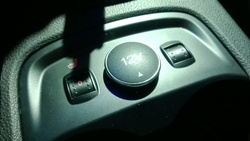 Finally, with the ST's fancy touchscreen and switchgear, I found it strange that the control for the heated seats was an analog dial. I didn't think there was anything analog left in modern automotive design.
Finally, with the ST's fancy touchscreen and switchgear, I found it strange that the control for the heated seats was an analog dial. I didn't think there was anything analog left in modern automotive design.
I'm left to recommend the Focus ST only as a rental. I'm sure it's fantastic to drive, and more and more I'm wishing auto shows had a road course where the car could be properly tested. So many of my criticisms could be overturned if a car was actually a dream to drive. The ST has flaws that can be overlooked with the attitude "Well, I won't have it that long."
Ford Mustang
Ford unveiled the next iteration of its pony car back in early December, but I guess two months isn't long enough to bring a car out of the barricades and onto the show floor. For the first time, I find the Mustang to be a truly handsome car.
The thing about past Mustangs is that even the base model would look fast and outlandish. There was no Mustang you could buy that a non-gearhead mother would approve of. With the new one's almost conservative looks, it'll now be possible to pass a police officer without fear of him immediately switching on his radar gun. And the second bonus is that there's lots of room for outlandish spoilers and hood scoops and swollen wheel arches on the inevitably upcoming Cobra model, as well as conversions by Roush or Hennessey.
I couldn't jump into the Mustang that everyone wanted to see, but on the floor was last year's Shelby Cobra. Couldn't pass that up, right?
For years, the Cobra nameplate has meant stuffing a lot more horses into Ford's pony car. They don't always do the best job of it, focusing on power over handling in the true drag racing spirit. This is a bit ironic, since the Ford/Shelby partnership was born from Le Mans racing the original AC Cobra. Tuning houses like Roush have done a better job of turning Mustangs into track monsters. Still, the Shelby Cobra name is revered by the Mustang community.
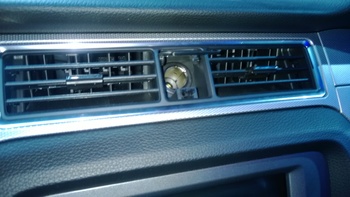 The interior of the Cobra doesn't really stand out in my mind. It's not that there's anything great about it, but it's not bad either. It isn't like the cramped Camaro or the cavernous Challenger. It just, sort of, fit. Like the Corvette, this could easily be an every day driver, because you're not distracted by an uncomfortable seat or flashy video screens.
The interior of the Cobra doesn't really stand out in my mind. It's not that there's anything great about it, but it's not bad either. It isn't like the cramped Camaro or the cavernous Challenger. It just, sort of, fit. Like the Corvette, this could easily be an every day driver, because you're not distracted by an uncomfortable seat or flashy video screens.
I did notice one curiosity, though. Most cars have (what used to be called) the cigarette lighter down on the center console. The Cobra had it up high between the air vents on the dash. Not where I would have put it. I would think you wouldn't want your phone charging cable dangling in front of the screen and possibly getting in the way of the shifter.
Fiat 500 Abarth
The return of Fiat to American shores excites me mostly because I want to see an Alfa Romeo in a local dealership.
Until then, we have this. This, in my opinion, is a better implementation of the small, fast, practical car than than the Focus from earlier. Sure, it's not as large, but I had no trouble getting in. However, because the car has such a short wheelbase, in order to fit four seats in it everyone needs sit very upright. This doesn't feel very sporty, but the car is light and will be nimble in the corners. I'm sure that makes up for an SUV-like seating orientation.
Mercedes-Benz
When Mercedes and McLaren decided to stop making the incredible SLR and not make a follow-up, they dropped a few points on my cool meter, though not as much as when they killed the Chrysler ME-412 project because it would have taken limelight away from the SLR (thus the premature death of yet another American supercar).
And they didn't gain any points at the show. The SLS wasn't available for seat time and I didn't see any AMG Black cars. In fact, with their focus on the front-wheel drive CLA, I get the feeling they're departing from making physics-bending cars like the SLR, which would set its brakes on fire when track racing so you knew they were working.
But really, the E 350 and CLS 550 I checked out ended up feeling like, well, a pair of Mercedes. The only thing that piqued my interest was the apparent return of the column shifter.
Hyundai Genesis Coupe
Hyundai made serious waves when they introduced the Genesis. It's no mistake they used the name "Genesis," the same word video game publisher Sega used when they decided to go toe-to-toe with Nintendo in the nineties. And I can see why the press got excited.
The Genesis Coupe definitely has the looks. Classic proportions and aggressive styling aim for the same market as the Nissan 370Z (which I didn't check out, because when I passed Nissan's booth I forgot they made the 370Z). And with the option of a 3.8 liter V6, it certainly competes with the V6 Mustang (although it will get smoked by the V8 Mustang).
But what threw me from the idea that this is a performance-oriented car was a fuel economy guage just below the infotainment screen and next to a torque meter. A physical gauge. It's not as if it's a digital guage on a video screen that can be pushed aside.
Honestly, if you just bought a 3.8 liter V6-powered sports car, I don't think fuel economy is your chief concern. Silly Koreans.
Lotus
The second disappointment of the show was the small non-display Lotus had. It really was nothing more than three of their cars within red rope barriers. Lotus has been struggling lately, and I'm half convinced it's because they don't give themselves a real presence in the States. Plus, I really wanted to check out the Elise and Evora. Such a shame, because the principle of "Simplify, and add lightness" is a beautiful cornerstone upon which to build a sports car.
Volkswagen (and other German Marques)
Volkswagen doesn't really have anything I like. Nothing against them, but I find the Beetle a deplorable handbag accessory. But what I thought hilarious about them (and BMW and Audi) was that all the cars were lined up facing the same way.
I'm thinking back to the last time we saw this many Germans all lined up, and, well, let's just say it wasn't pretty.
Jaguar F-Type
The world has been waiting for a true successor to the legendary E-Type Jag for forty years. And when the F-Type finally bowed, we all wondered why it came with an 8-speed automatic gearbox instead of a proper stick-shift, or even a dual-clutch. Still, it looks fantastic.
But I forgot that Europe is a claustrophobic place. It is snug in there. But it's not like the Camaro, which was just a small place in a big car. The F-Type is meant to keep you in place as you corner, when the centrifugal force of momentum tries to overcome the structural integrity of your seat belt.
I don't know if this could be an every day car. Maybe if I was of a shorter stature, but my 6'4" frame had only room to breathe. Maybe there were additional seat controls I couldn't find, but even those couldn't adjust how wide the seat was. Then again, I'm tall even for an American, and this car was built for England. I still wouldn't say no to the car, because it still looks fantastic, and you don't have to fit in it to know this.
Cadillac XTS
Cadillac has made great strides since they hit a home run with the CTS-V. The XTS is descended from the DTS, Cadillac's front-wheel drive full sized sedan. Popular with the older crowd for the old Caddy boat feel and the ample room in the back, the DTS lived for six years, and before that it was the DeVille for twenty years. It may not be a particularly exciting car, but it sold.

Enter, the XTS. There are benefits to front-wheel drive in this sort of large sedan. First, the lack of a driveshaft means a flat floor in the rear footwell while still keeping the car low. There's also a fuel economy advantage, since the engine doesn't have to push the weight of the driveshaft and rear axle.
But all of that doesn't matter, because the XTS is just a very nice place to be in. It felt like a trimmed out Linocoln Town Car. Very comfortable in a relaxed way, not so much a supportive one. This car is for freeway driving with the cruise control while listening to classical music. Like I said, old people.
But what I didn't like was Cadillac's Cue system. The touchscreen is equipped with a haptic feedback system that vibrates when a control is touched. Now, that's great on a phone, that you hold in your hand. But this is in a car, that already has a dozen things vibrating in the engine bay, and the average road surface isn't exactly NASA-grade levels of flat. Rather pointless, I'd say.
BMW M4
The new M3 Coupe has had a name change. In fact, all the 3-Series Coupes are now the BMW 4-Series, while the sedans remain the 3-Series. Kind of like how the 6-Series is the 5-Series Coupe. Things get confusing with the Grand Coupe models, but we'll gloss over that for now.
For now, we have the M4. And straight away, there's a problem. Not so much with the car (although the M4 will not be available with a manual transmission), but with BMW as a whole. If you buy a BMW M product, they really want you to know about it. Just look how many Ms are in the cabin alone:
Seems a bit excessive. I'm pretty sure anyone buying an M product is already quite aware of what they've bought. There's no need to beat them over the head with it.
But I guess it's par for the course with typical BMW owners. They're used to having the phrase "Ultimate Driving Machine" laser etched onto their retinas every time they get in their passion-mobile. But of course, the retina-scorching lasers would be an optional extra that the dealer would make you happy to buy.
My initial impression was one of "buttons." There are a lot of driving systems in the contemporary M cars, and I'm pleased they have actual dedicated buttons to control them. The current trend is to put everything in the touchscreen menu. That might be fine for someone like me, who likes to dig into settings to fine tune his experience, but only initially. Eventually, I like to have quick access to important systems, and having to wait until I reach a red light to change the suspension settings to compensate for a bumpy road would get old after the first time.
I don't really have a lasting impression of the M4. So I moved on to...
BMW 435i
...the lesser edition.
Let me get this out of the way: I loved it! With that done, let me get into the nitty-gritty.
The only compliment I've been able to give BMW for years is "I like the 6-Series." Sure, the 7 is nicer, and probably easier to live with, but thats a car you hire a guy with a hat and gloves to drive for you. Not a driver's car. And I like the shape of their coupes, but I felt like the 3-Series looked a bit... goofy. With the new 4 emulating the sleek 6, that qualm is gone, and there's finally an "affordable" BMW I could get behind.
And get behind I did. The 435i fit like a glove. Every control came readily to hand. The seat was bolstered, yet had room to breathe. The shifter (yes, this was a stick-shift model) had a measured, reassuring throw. And the display on the dash is well-positioned for quick reference to navigation info. Above all, it's just a really nice place to be. Sure, I said that about the Cadillac XTS, but where that was a nice place to sit, this was nice in terms of being engaging. The cabin layout is all about taking control of the car, not setting the cruise control and lane departure assist.
My favorite moment was when I was messing around with the iDrive menu system, and I stumbled on something rather awesome. It looks like BMW loaded the entire user's manual into the system, including a reference to Band-Aids, and made it searchable via an index. A car that comes with its own reading material. That's just fantastic!
And I didn't learn this until later, but the iDrive control wheel also has a capacitive touchpad sensor. This isn't for navigation, but rather for writing letters with your finger to quickly access menu items. Had I known this at the time, I probably would have spent all day drawing letters on the little circle. It's that kind of neat-o innovation that I like, because it doesn't take away from or interfere with the prime function of a car, which is still getting from A to B.
I must have spent longer in the 435i than any other car at the show. It helped that this show isn't well attended by enthusiasts such as myself, so most people who spotted it said "It doesn't have back doors," and moved on, giving me time to soak it in. I dare say I may have found the car I will actually buy if ever I get the itch(y palms).
Audi
Audis should appeal to me. They've got a strong rally heritage, they can get a lot of power out of a 2.0 liter four-pot, they handle incredibly well (despite how far forward they mount their engines), and their V8s are fantastic.
But they just look... kind of bland. Yes, the S models are handsome, but you have to get into the prohibitively expensive RS line to get any kind of spark visually. I'm sure I sound like a hypocrite, because I laude the Pontiac GTO of 2004 to 2006 because its sleeper looks didn't look as outlandish as the Mustang of the time. But this is German, and you're more hard-pressed to find an exciting-looking German sports car that isn't a Porsche than you are an American sports car. (With any luck, the good looks of the 4-Series should change this trend.) The irony there is that in Germany, the brightly-colored cars sell better, because they're more visible -- and therefore, safer -- on the Autobahn. Stateside, dull, gray- and black-colored cars sell better, because they're less likely to be pulled over.
Enter the R8 V10. It looks outlandish (for an Audi) and goes like stink. But, being European, it is also stupid expensive. And they didn't even unlock the door, so no one could sit in it. The sole redeeming feature of the R8 at the show was the pretty matte paint, which was covered in fingerprints.
Sorry, Europe, but from here on out, the answer to every one of your sports cars in the 100-200k range will be the Corvette Stingray. You have been trumped.
Lincoln
I had been wondering all show where Lincoln was. Turns out they were hiding among the Germans. Odd, considering the domestics were upstairs. I would have thought Chrysler would be down there, given they were once owned by ze Germans.
 I almost gave them a pass, since the recent models don't really stir me with their whale-tail grilles, but one thing caught my eye. It was the cleverly-engineered sunroof that slides over top of the rear window. Obviously, where else are they going to put it, but the sleek design make it look a bit like a spoiler, despite the fact that a spoiler of that shape would actually increase lift, which spoils handling at speed. But no matter. It caught my attention, and the MKZ got some of my time.
I almost gave them a pass, since the recent models don't really stir me with their whale-tail grilles, but one thing caught my eye. It was the cleverly-engineered sunroof that slides over top of the rear window. Obviously, where else are they going to put it, but the sleek design make it look a bit like a spoiler, despite the fact that a spoiler of that shape would actually increase lift, which spoils handling at speed. But no matter. It caught my attention, and the MKZ got some of my time.
Beyond the somewhat awkward front fascia, this is a nice looking car. The lines aren't very Lincoln-esque, if you ask me. The Town Car still jumps to mind every time I think of the brand, and that kept the same shape for decades. Perhaps it's good that Lincoln is trying a new direction, but it will take some time for me (and probably others) to shake the strong connection they had with their bread-and-butter sedan.
 Inside, it looks like Lincoln and Cadillac are taking from each other's playbooks. The dash and console are designed to have as few buttons as possible. That's great for a smartphone, but in a car it falls flat for reasons I stated above. And what buttons it has aren't really there. They're more like touch controls, which work great as you're bumping along a surface street. I'm told Detroit's streets look like a teenager's face, so I would hope Ford tested this car on real streets, because with touch controls you'd best have a smooth ride.
Inside, it looks like Lincoln and Cadillac are taking from each other's playbooks. The dash and console are designed to have as few buttons as possible. That's great for a smartphone, but in a car it falls flat for reasons I stated above. And what buttons it has aren't really there. They're more like touch controls, which work great as you're bumping along a surface street. I'm told Detroit's streets look like a teenager's face, so I would hope Ford tested this car on real streets, because with touch controls you'd best have a smooth ride.
Years ago, some automakers toyed with the idea of a push-button transmission. The idea was that instead of moving a lever, you would press a button to select park, drive, reverse or neutral. As ideas go, it wasn't the best. Automakers still hadn't figured out how to make good buttons, so they were prone to quality issues. These could only work with automatic transmissions, and manually selecting a low gear for tricky road conditions wasn't much of an option, so this relegated the feature to luxury cars, and luxury car buyers don't like running into quality issues.
Flash forward, and we're seeing push-button transmissions again. Automakers finally figured out buttons, so these will actually work, and most up-scale cars are coming with paddle-shifters, so selecting low gears is possible again. Hense, the MKZ has a series of buttons for selecting a drive, reverse, etc.
Here's my problem with it: as someone who's quite accustomed to having a shifter on the console or steering wheel column, I get a sense of where the shifter is and by feel I can select a gear. Buttons on the dash, especially when they're flush to the dash like on the MKZ, are something you need to look at in order to find the right one, lest you reverse on your daughter's new puppy.
Nitpicks aside, the Lincoln feels about as nice as the Cadillac. Luxury buyers are definitely not short for choice these days, particularly among the domestics. It's a shame they're all going to crash when distracted by the touchscreen.
Conclusion
As I left the autoshow, buying a pair of automaker logo flags from a vendor, I reflected back on the experience. There were some surprises, and also some letdowns. Let's roll through them.
Prettiest in Show
 This is biased, I know. It's always going to be the Viper for me. The redesign is a vast improvement over the old one, and that looked good, too. It looks like nothing else on the road, and you'd never mistake it for something slow. The engineering of the car was all about stuffing that massive engine into a car the size of a Porsche 911, and they came out with a classically-proportioned sports car.
This is biased, I know. It's always going to be the Viper for me. The redesign is a vast improvement over the old one, and that looked good, too. It looks like nothing else on the road, and you'd never mistake it for something slow. The engineering of the car was all about stuffing that massive engine into a car the size of a Porsche 911, and they came out with a classically-proportioned sports car.
Like I said, the Viper is the car that got me interested in cars. I'll always have a soft spot for the snake, no matter how good the Corvette gets. I can't wait to put one in my garage (some day in the future, obviously).
Surprise of the Show
 I didn't think I'd like the 4-Series as much as I did. For years I scoffed at BMW and its drivers, thinking they were just drinking the "Ultimate Driving Machine" Kool-Aid. Well, I've got a helping of crow on my plate. (Truth be told, it actually tastes delicious when marinated in teriyaki sauce.)
I didn't think I'd like the 4-Series as much as I did. For years I scoffed at BMW and its drivers, thinking they were just drinking the "Ultimate Driving Machine" Kool-Aid. Well, I've got a helping of crow on my plate. (Truth be told, it actually tastes delicious when marinated in teriyaki sauce.)
But the surprise of the 435i is bolstered by how much I was turned off from the M4. It just didn't appeal to me, and by all indications it should have, despite the absence of a manual. Perhaps if I had checked out the lower-spec model first, I might have appreciated the M4 better. I still can't get over how many Ms were in that car.
Best Cup Holder
Goes to the Lincoln MKZ. Just look at this opening sequence:
I could watch it all day.
Unfortunate disappointments
Here we have a tie. By all logic, these should both be great cars. A fast Ford hatch and a Chevy muscle. But both are let down by interiors. The Chevy is meant to appeal to middle America, but unfortunately middle America may not fit in the cabin, nor can they see out of it. And the Ford suffers from inconsistency. Ford spent too much time developing fancy graphics for the screens but skipped the quality switchgear, then it bolstered the seats so much they become hard to get into. And the two automakers seemed to be on such an upswing. I hope these are only anomalies.
Best Car in DC
As I left the show (and, indeed, the Convention Center), I spied a great car. Its looks were dated, it didn't have a particularly powerful engine, it was covered with salt from the recent snows and you won't find a new car in that shade of green anymore. There were dents and scratches on the side, the rear bumper had been hit at one point, and the paint was peeling off the plastic nose. Inside, it wasn't particularly well-equiped, the materials were cheap, and the sound system is lucky to have Bluetooth connectivity. The suspension isn't Cadillac-smooth, nor is it Aston Martin-solid. It hasn't got a lot of power, but it has a throaty rumble. The transmission is only a three-speed automatic with overdrive, so fuel economy isn't the best.
But it's got charm that grows over time. Above all, it's mine.
 2014 Washington Auto Show,
2014 Washington Auto Show,  auto show,
auto show,  cars | in
cars | in  LeadFoot
LeadFoot 
